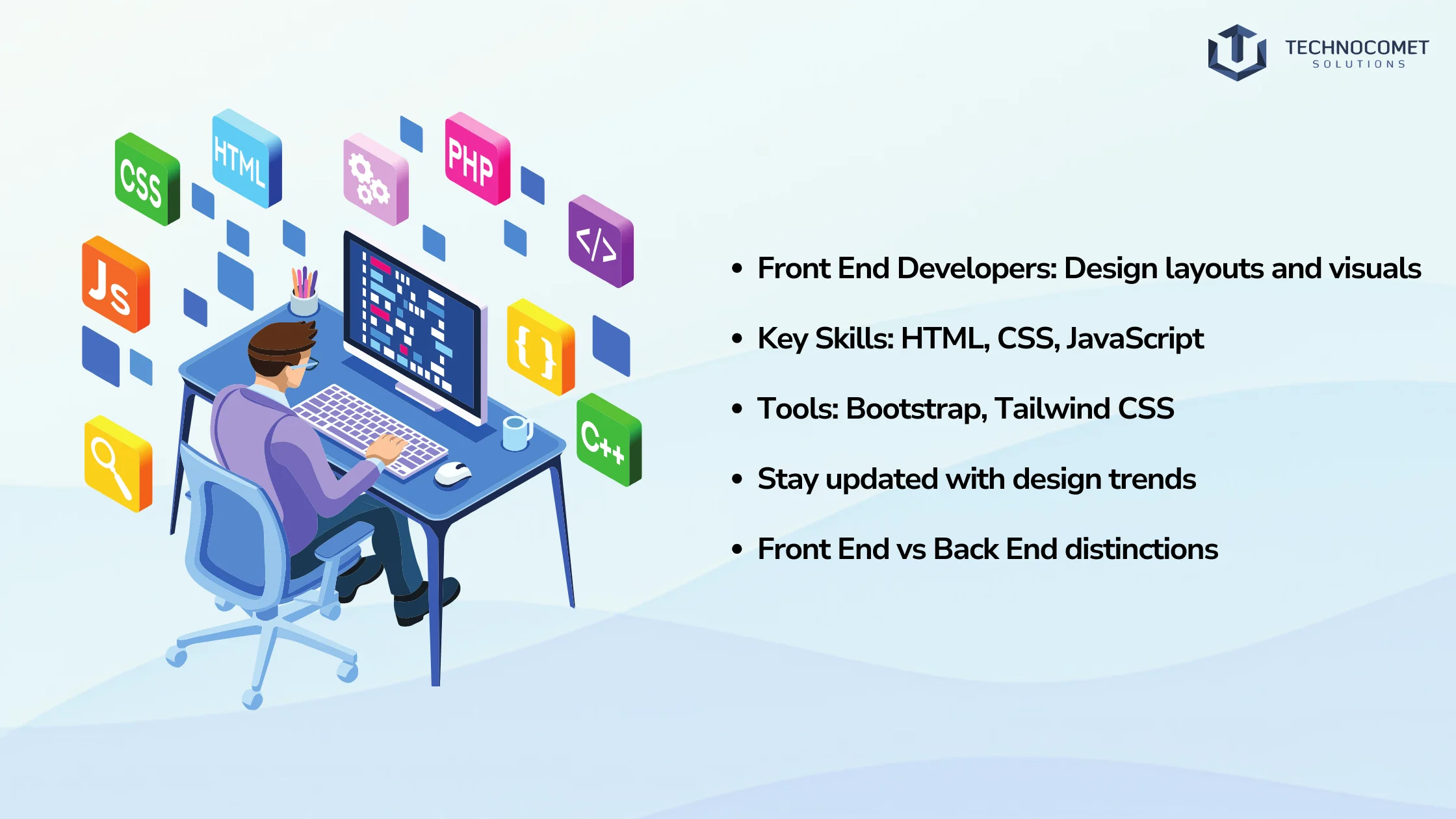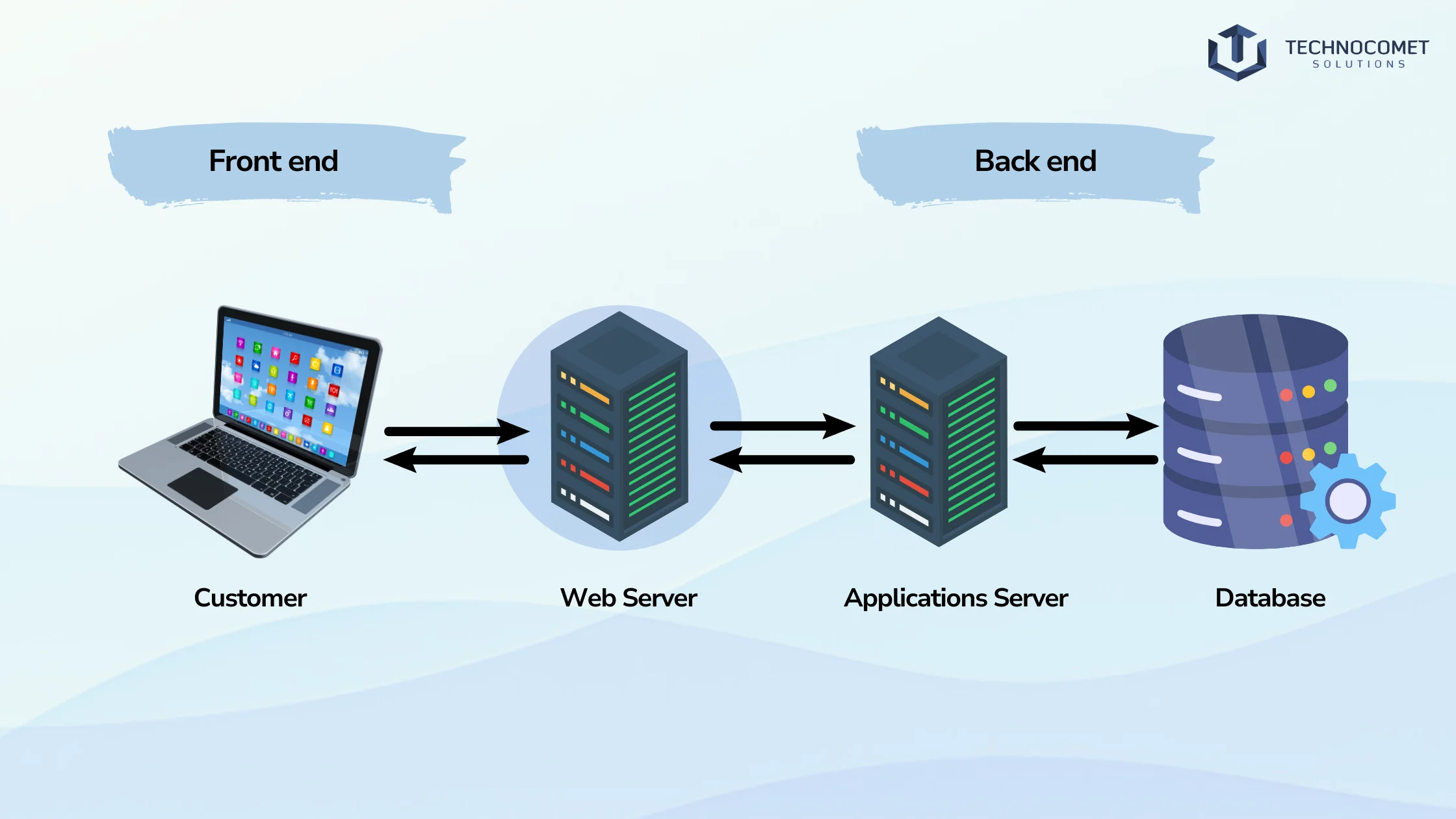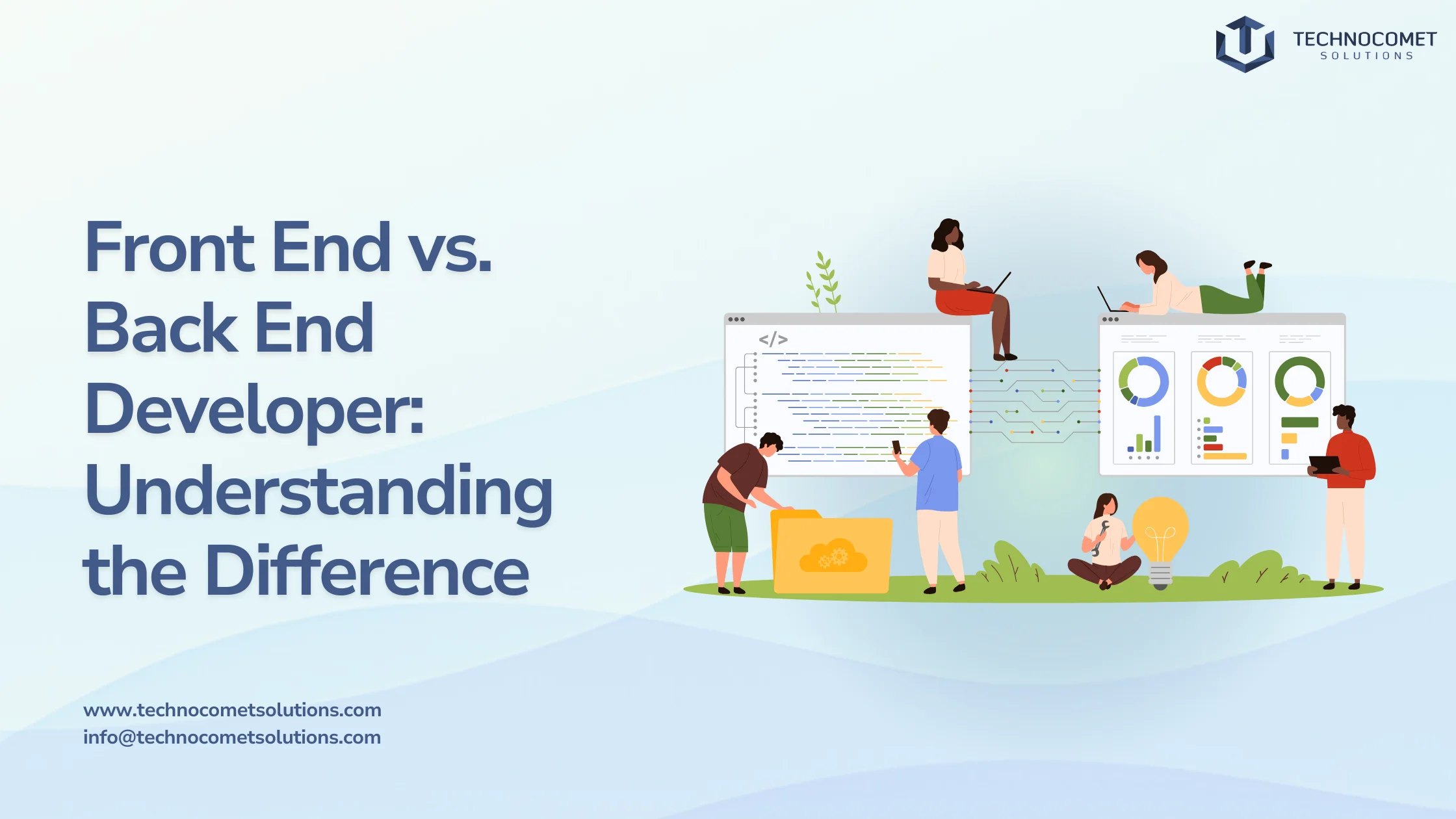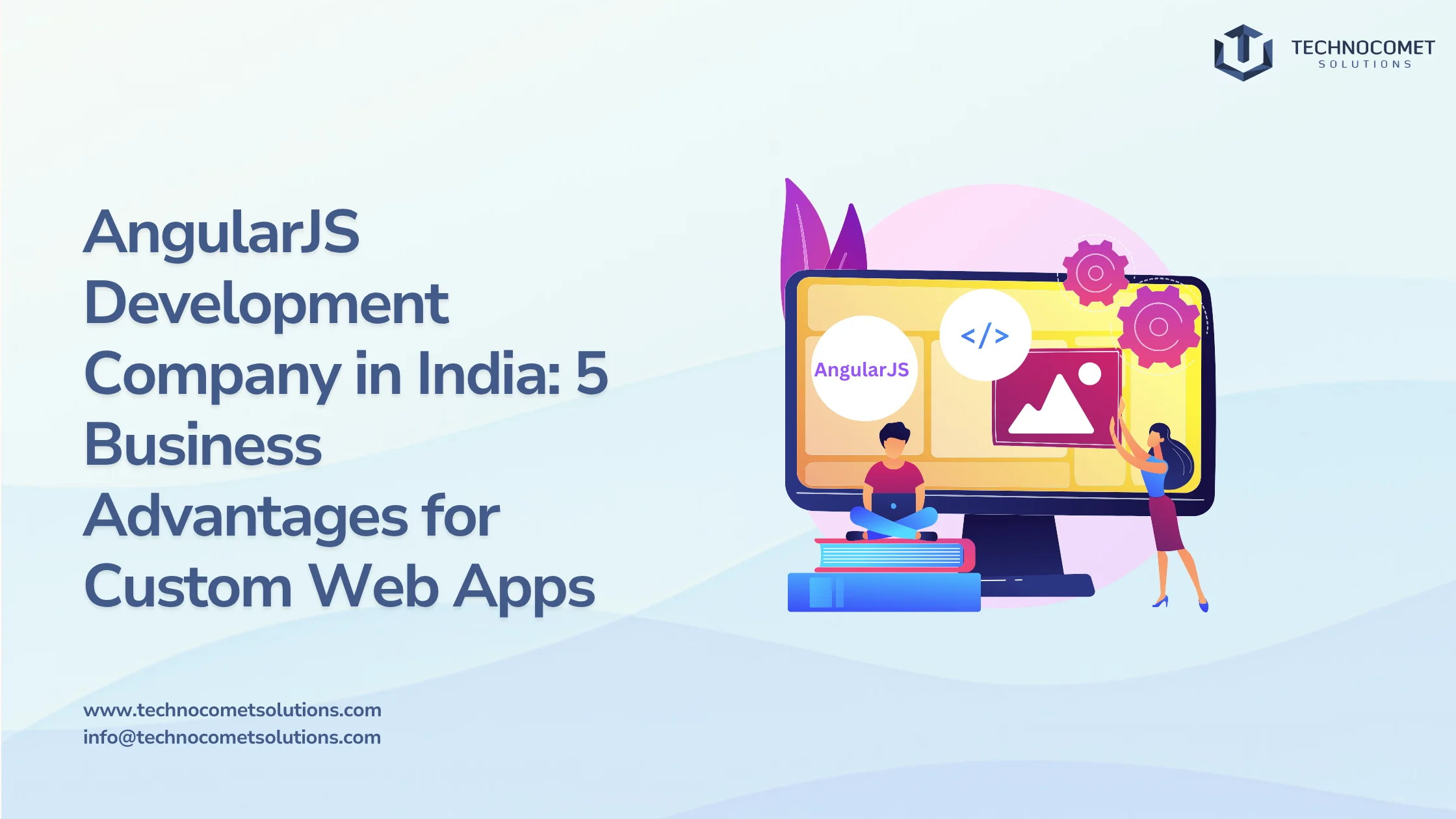Introduction
In the world of web development, understanding the roles of a front end vs back end developer is essential for creating a balanced web experience. The front end represents everything that users interact with directly, while the back end encompasses the behind-the-scenes processes that make a website function. Grasping these distinct roles is crucial, as it allows developers to see how their work contributes to the bigger picture. At Technocomet Solutions, we emphasize the importance of this knowledge, as it not only enhances individual performance but also fosters better teamwork among various development roles.
In this blog, we will explore the differences between front end vs back end developer, highlighting their unique responsibilities and skills.
Overview of Front End vs Back End Developer Roles in Web Development
In the world of web development, two primary roles stand out: front end vs back end developer. Understanding the distinction between these roles is crucial for anyone looking to navigate the digital landscape effectively. Front end developers are responsible for creating the visual aspects of a website, ensuring that users have an engaging and intuitive experience. They focus on the design, layout, and interactivity that users directly engage with. On the other hand, back end developers manage the server-side components that power applications, making sure everything functions correctly behind the scenes.
The Importance of Understanding Both Sides for a Balanced Web Experience
Front end developers focus on the visual aspects of websites—the parts users interact with directly. They are responsible for crafting user interfaces that are not only functional but also aesthetically pleasing. This includes ensuring that websites are responsive and accessible to all users. In contrast, back end developers work behind the scenes, managing databases, servers, and application logic to ensure that everything runs smoothly. A solid understanding of both front end vs back end developer skills is essential for creating a seamless user experience.

What is a Front End Developer? Responsibilities and Key Skills
Crafting User Experiences: Designing Visual Elements and Layouts
Front end developers are tasked with designing the layout and visual elements of a website. This includes everything from color schemes to typography and interactive features. Their primary goal is to create an engaging user experience that draws visitors in and keeps them on the site longer. They use languages such as HTML, CSS, and JavaScript to bring their designs to life, ensuring that every element is responsive and visually appealing. Additionally, front end vs back end developer distinctions help define the separate skills each role requires, with front end developers needing to stay updated with design trends in a rapidly changing digital landscape.
Essential Skills for Front End Developers: HTML, CSS, JavaScript, and Beyond
Front end developers must master several key skills to succeed in their roles. Proficiency in HTML provides the structure for web pages, while CSS is equally important as it controls the visual presentation of that content. JavaScript adds a layer of interactivity that is crucial for modern web applications. In addition to these core technologies, front end developers should be familiar with various libraries and frameworks that can streamline their workflow and enhance functionality. Tools like Bootstrap or Tailwind CSS can help in creating responsive designs quickly while maintaining aesthetic appeal. Understanding front end vs back end developer skills is crucial to balancing design with functionality.
What is a Back End Developer? Core Functions and Technologies
Building the Backbone: Managing Databases, Servers, and Application Logic
Back end developers focus on server-side logic and database management. They ensure that data flows seamlessly between the server and the client side of applications. This involves writing APIs (application programming Interfaces) that allow different parts of a web application to communicate effectively. Understanding the front end vs back end developer role distinctions here, back end developers also manage user authentication, data storage solutions, and server configuration, ensuring security measures are in place to protect sensitive information.
Key Skills for Back End Developers: Programming Languages, Frameworks, and Database Knowledge
To excel in their roles, back end developers must be proficient in several programming languages commonly used in server-side development. Languages like PHP, Ruby on Rails, Python, or Node.JS are essential tools for building robust applications that can handle complex data operations efficiently. Additionally, they should have a strong command over database technologies such as MySQL or MongoDB to manage data effectively while ensuring its integrity and security at all times. Security is another critical aspect of back end development; developers must ensure that their applications are secure from potential threats while optimizing performance for users through effective coding practices. This focus on security underscores the value of front end vs back end developer collaboration in achieving user trust.
Front End Technologies: Tools and Frameworks that Shape the User Interface
Popular Front End Frameworks and Libraries: React, Angular, Vue.js
Front end development has evolved significantly with the introduction of various frameworks that streamline the development process. Popular choices among front end developers include React—a library for building user interfaces—Angular—a platform for building mobile and desktop web applications—and Vue.js—a progressive framework designed for building user interfaces incrementally. These tools allow developers to create dynamic single-page applications (SPAs) that enhance user engagement by providing smooth transitions between different views without requiring full page reloads. The front end vs back end developer contrast is particularly evident here, as each has unique tools and approaches.
The Role of Responsive Design and Accessibility in Front End Development
Additionally, responsive design ensures that websites function well on various devices, while accessibility focuses on making web content usable for people with disabilities. Both aspects are crucial for enhancing user experience across diverse audiences who may access websites from different platforms or devices at any time during their browsing journey online today! A well-designed website should adapt its layout depending on screen size while also being navigable by all users regardless of their abilities or tools they may be using (like screen readers). This makes front end vs back end developer collaboration key to achieving accessibility standards.
Back End Technologies: Behind-the-Scenes Tools and Frameworks
Exploring Common Back End Frameworks: Node.js, Django, Ruby on Rails
Back end technologies are vital for creating robust applications that can handle large volumes of traffic efficiently while maintaining optimal performance standards throughout usage periods across varying conditions encountered daily. Common frameworks used by back end developers include Node.js—which allows JavaScript to be used on the server side—Django—a high-level Python framework that encourages rapid development—and Ruby on Rails—which emphasizes convention over configuration principles aimed at simplifying coding efforts overall. Understanding these tools in a front end vs back end developer context helps clarify how they uniquely contribute to overall functionality.
Database Management: SQL vs. NoSQL and the Role of Databases in Web Applications
Databases play a critical role in back end development as well; they serve as repositories where all application-related information gets stored securely while being readily accessible whenever needed by authorized personnel only. Developers often choose between SQL databases (like MySQL) or NoSQL databases (like MongoDB) based on their project needs—each type offering unique advantages suited toward specific scenarios encountered during implementation phases. The front end vs back end developer relationship is reinforced through efficient database management for data-intensive applications.

How Front End vs Back End Developer Collaborate
Bridging the Gap: How APIs Enable Front End and Back End Interaction
APIs are essential for enabling communication between front-end and back-end systems; they allow front-end developers to request data from back-end servers seamlessly while ensuring secure transactions occur without exposing sensitive information directly to users at any point during interactions taking place online today. This interaction forms the backbone of modern web applications where dynamic content updates rely heavily upon efficient API calls executed promptly whenever necessary throughout usage periods experienced daily!
The Role of Full-Stack Developers in Unifying Front End and Back End
Additionally, full-stack developers possess skills in both front-end and back-end technologies, which enables them to be uniquely positioned within teams tasked with delivering comprehensive solutions capable of addressing diverse challenges faced throughout project lifecycles. This versatility allows them to not only work across both areas—facilitating better communication between teams—but also ensures projects progress smoothly from conception through deployment stages while addressing potential issues early on during development cycles. Full-stack skills serve to bridge the front end vs back end developer gap effectively.
Front End vs Back End: Key Differences in Skills, Tools, and Focus
Contrasting Front End’s Visual Focus with Back End’s Technical Foundation
The primary difference between front end vs back end developer roles lies primarily within their respective focus areas; front-end developers prioritize user experience through visual design, while back-end developers concentrate primarily upon functionality alongside data management required, ultimately supporting those designs effectively implemented across various platforms utilized widely today.
A Day in the Life: How Front End and Back End Workflows Differ
A typical day for a front-end developer may involve collaborating closely alongside designers tasked specifically toward creating mockups or testing website responsiveness across devices while ensuring all elements function correctly based upon user interactions defined clearly during business requirements set forth throughout planning phases! Conversely, back-end developers might spend their day writing server-side code aimed specifically at optimizing database queries designed ultimately toward improving performance metrics identified through analytics tools utilized regularly during operational assessments conducted frequently.
Career Paths and Opportunities for Front End vs Back End Developer
Job Market Demand and Growth Potential for Each Role
Both front end vs back end developer positions remain consistently high-demand professions within today’s rapidly evolving digital landscape. This trend indicates strong growth potential across various industries seeking skilled professionals who can contribute effectively toward achieving organizational goals through innovative solutions customized specifically around customer needs identified clearly throughout market research efforts conducted regularly!
Transitioning Between Roles: From Front End to Back End and Vice Versa
Many developers choose instead to specialize within one area but may transition between front end vs back end developer roles as they develop their skills further over time; this flexibility enhances career prospects significantly by broadening expertise across multiple domains within software engineering disciplines encountered frequently throughout industry practices observed widely today!
Conclusion
In conclusion, understanding differences between front end vs back end developer roles remains essential for anyone interested in pursuing careers within web development today; each role brings unique skills necessary toward creating engaging digital experiences while ensuring everything runs smoothly behind the scenes—allowing businesses greater opportunities to reach customers effectively online! Emphasizing cooperation among front end vs back end developer teams leads ultimately toward more cohesive projects capable of delivering seamless experiences across digital platforms customized specifically around user expectations encountered regularly throughout interactions experienced daily!
Are you ready to elevate your online presence with expert web development services? At TechnoComet Solutions, we specialize in both front end and back end development, ensuring your website not only looks great but also functions seamlessly. Contact us today!
FAQs
A front end developer focuses on the visual aspects of a website that users interact with, while a back end developer handles the server-side logic and database management that powers the site.
Yes, a full-stack developer possesses skills in both front end and back end development, allowing them to work on all aspects of a web application.
Front end developers should be proficient in HTML, CSS, and JavaScript, along with familiarity with frameworks like React or Angular to create interactive user interfaces.
Back end developers commonly use languages such as Python, Ruby, PHP, and Java to build server-side applications and manage databases.






